
The Church
As this is a guide to ‘the church’ we really need to recognise the building itself and the design produced by the architect and the principles on which he designed it.
The principles included the concept of enveloping the structure to gather the congregation around the sanctuary. The openness of sanctuary allows the congregation to join with the celebrant during a service, no barriers or distance separating them. The positioning of the baptismal font to the left of the sanctuary shows us it in relationship to the tabernacle and the altar table.
The three focal points of the church as clearly separated yet can be viewed in relation to one another, the shared tabernacle placed to the left of the altar, its position here follows he new liturgical guidelines that it should have its own distinctive and important position without vying with the altar of sacrifice. The single altar table is a sign of our common calling to share the body and blood of Christ to join around one table as a shared community and the one lectern so that we all may hear the word of God.
The architects of St Basil’s & All Saints Richard O’Mahony & Partners gave this outline to the work they had undertaken:
-
A new church building should be a visual and symbolic focus of its immediate environment. This is so especially when the declared intention is that it should not only serve one denomination.
-
St Basil’s & All Saints has therefore been sited in a dominant position between the existing R.C. presbytery and the new Anglican vicarage which completes the complex of buildings.
-
In linking the two houses we have sought to design a building, which gathers people in and conveys a feeling of welcome and hospitality. Warm. Natural materials have been used and yet the interior is one, which has the space, light and height to elevate the spirit and be conducive to prayer.
-
The weekday chapel, which also serves as a meeting room, forms the first connection between Catholic and Anglican activities. By means of a folding screen it can also allow the room to be used as a part of the church itself when numbers over 200 have to be accommodated.
-
The sanctuary furniture and short benches of beach and pine are substantial but moveable so that developments of liturgical use need not be inhibited
Commemorative stones
In the Church porch, pride of place is taken by the foundation stone. The words on the stone are:
TO THE GLORY OF GOD & IN HONOUR OF ST BASIL’S & ALL SAINTS
Immediately above it is a plaque, somewhat larger than the stone itself, is a plaque that explains that Pope John Paul II blessed the stone during his pastoral visit to Britain at Pentecost 1982. Archbishop Dereck Worlock and Bishop David Sheppard dedicated the stone at the solemn opening of St Basil’s & All Saints on the 22nd March 1983. In his address that evening the Archbishop, referring to a sermon by Pope John Paul II the previous summer, said, “I believe that the commemorative stone which we are dedicating tonight, is a symbol of your becoming stones in the beautiful edifice of Christian unity, with the apostles for foundations and with Christ the corner stone”.
Those who are most observant will note that in one corner the stone is unfortunately cracked, not quite perfect. How fitting that is though, considering the words of the Archbishop. It should serve as a reminder that each of us, unsuitable and inadequate as we perceive ourselves to be, we can make a real contribution to the cause of unity and peace in this community and in the world at large.
There is also a commemorative brick in the body of the Church. This carries the official logo of Pope John Paul II’s visit to Britain in 1982 and can be found near the statue of Our Lady.
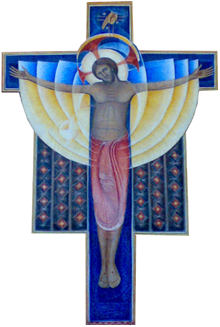 Crucifix
Crucifix
Entering the church your eyes are naturally drawn upwards to the crucifix high on the wall behind the altar
The crucifix was a gift to the new church from Archbishop Dereck Worlock and Bishop David Sheppard. It was designed and painted by Stephen Foster and took six months to complete, as a great deal of study and experiment was necessary; it is based on the early Tuscan crucifix that was very much part of religious expression in the middle ages. The colouring was achieved using an egg tempra technique, which was developed, by the monks and artists of the early church. It is a process of mixing raw pigment and egg yolk.
Christ is depicted with eyes open, expressing resurrection and victory over death. God’s love is symbolised in the red of the garment; His Holy Spirit is portrayed in the yellow arch; and His Godhead is expressed in the hand at the top of the painting and the blue background. The earth coloured diamond designs depict the falling of God’s grace on mankind.
From the wound in Christ’s side come blood and water, symbols of the human and divine. They flow into a chalice as a reminder that at the Eucharist we partake of his body and blood.
The Font
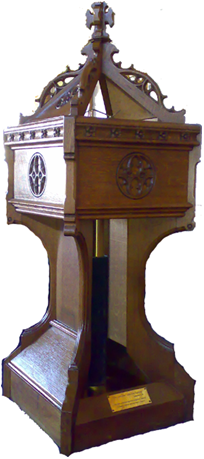 The font is a strange mixture of both traditional and modern styles. It comprises sections of both the former St Basils and All Saints fonts. The wooden, more traditional part is made from oak and was formerly the font used in St Basils. The font used by the Anglicans when they used to worship in All Saints School was part of a set. It’s more modern design can still be seen in the new font and in the tall paschal candleholder.
The font is a strange mixture of both traditional and modern styles. It comprises sections of both the former St Basils and All Saints fonts. The wooden, more traditional part is made from oak and was formerly the font used in St Basils. The font used by the Anglicans when they used to worship in All Saints School was part of a set. It’s more modern design can still be seen in the new font and in the tall paschal candleholder.
It is important to note, however, that the new font is not an easy compromise, built from a little of both former fonts to appease both congregations. Romantic though that may seem, there is more to it than that.
Whilst vestiges of the two former fonts can be made out, representing two former communities, there is only one font. It is therefore, representative of our determination to present our common Christian identity. We are reminded by the inscription on it’s base, taken from Ephesians, that despite our historical differences, there is only “one lord, one faith, one baptism” and it is right therefore, that we should affirm our shared belief by using one font for all Baptisms in the Church, regardless of denomination.
Whilst the font, in part, can be traced before the church was built, most of the other items of interest were commissioned especially.
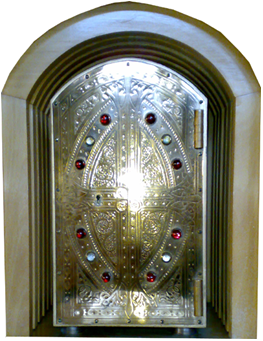 The Tabernacle
The Tabernacle
More than any other fixture the tabernacle reflects the progress the shared Church has made in 25 years. To appreciate this fully it is necessary to first understand more about the function of the tabernacle.
When the Celebrant prepares the Sacrament during Mass or Eucharist, it may be appropriate to keep back a small amount of the sacrament for use during visits to the sick or housebound later in the week.
Such is the symbolism that is attached to the elements during the service, that if they are to be reserved they should be locked away reverently in a place of safekeeping. Traditionally a tabernacle built of solid metal or wood with a lockable door has been used for the purpose, this is then securely fixed to the actual structure of the church.
The brass tabernacle that can be seen in the main Church was donated by Rev. W Strype in memory of his wife, Nora. It’s housing has been designed to follow the convex shape whilst conforming to the lattice design of the other sanctuary furniture, which is made of beech.
At each service and the special joint services the Priests from each denomination consecrates separate elements and distribute only to their own congregation. It follows then that when the sacrament is to be reserved there should be no risk of confusion, and so during the first few years of the Church’s life the Catholic Sacrament was reserved in the tabernacle, whilst the Anglicans reserved firstly in the church safe, and later in a second tabernacle which was located in the side chapel.
However, this arrangement was not felt to project the general trend of sharing and unity and might even be perceived as a definite division. Furthermore, a church safe was not the most reverent place to keep the body and blood of Christ.
Our Lady Statue
This statue of the Virgin Mary shows her as a young woman in peasant clothing presenting her smiling child to the world. This simple, modern representation of Mary was chosen to be in keeping with the style of architecture of the building.
The Ladies Confraternity presented the statue to the parish in 1983.
Community Quilt
This contemporary piece of art was the produced as part of a project in 2002 that aimed to bring all the church groups together to design and make a square which when combined together would show how by working together they cover the whole community with love, care and prayer.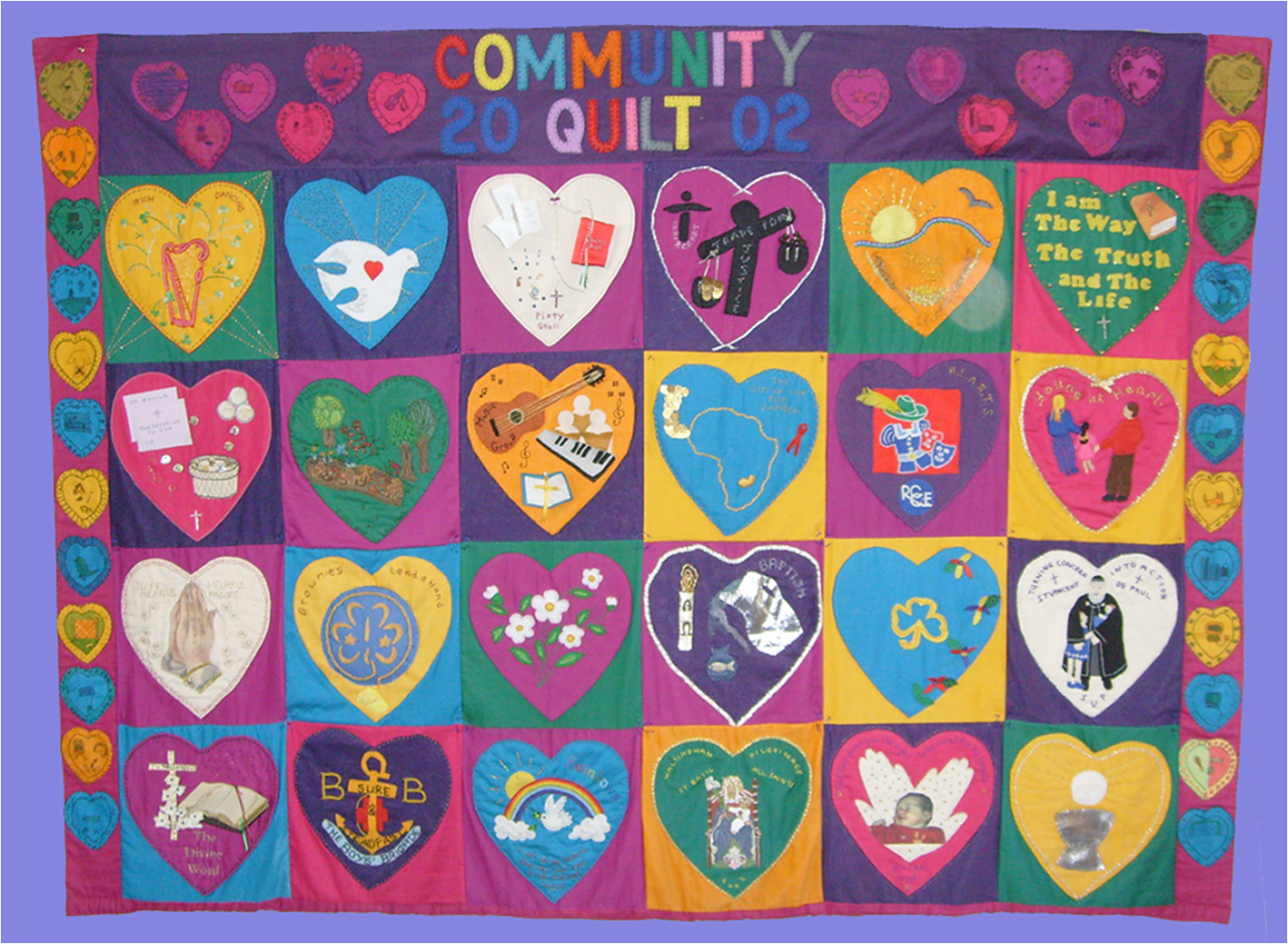
Under the skilful eye of Sue Archer 24 parish groups came forward to be represented. They are;
Adult Education Baptism Focus Boys brigade
Brownies Child Protection Church Cleaning
Confirmation Group Counters Eucharistic Minister
Morning Prayer Group Flower Arranging Garden of Hope
Gift of Life Guides Irish Dancing
Music Group Piety Stall Rainbows
Readers S.V.P. Tradecraft
Walsingham Young at Heart
The two primary schools of St Basil’s and All Saints were asked to design the border for the quilt. One class from each school was involved. The children thought of an activity they enjoyed and this is what they depicted on the small hearts. An accompanying book with photos accrediting each community square, and explaining the thoughts behind it can be found on the table in front of the quilt.
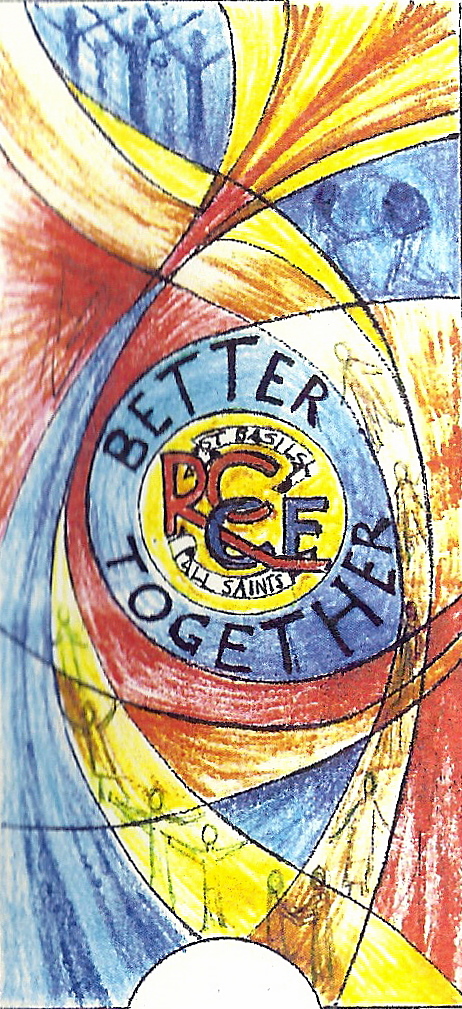 Hanging
Hanging
This new wall hanging will commeorate our 25th anniversary. It was the wish of Fr Kevin Kelly (recently retired Catholic Priest) that this new wall hanging should complement the crucifix given to us by archbishop Derek Worlock and Bishop David Shepard at our inaugural service, and also show something of our life here at St Basil and All Saints.
Sister Anthony from the art studio at the metropolitan Cathedral of Christ the King produced the design after visiting the church and learning more about our shared story.
The red, yellow and orange sections represent the Holy Spirit.
The blue sections stand for the waters of our common baptism.
The blue figures at the top represent the joys we share together, whilst the other blue figures stand for shared sorrows.
The other figures are people travelling on our journey of faith. They may be at different places on this journey but ultimately they come together and rejoice.
The hanging like the others in the church will be made by the efforts of the community. That way we all share in its beauty when we adding yet another unique piece of art work to our church.
OUR PARISH CENTRE
We have a wonderful Parish Centre thanks to the hard work of the steward the staff and the club committee. It hosts all kinds of activities throughout the week. Each evening you can come along for a game of snooker or billiards or just relax have a drink and a friendly chat. Mid week we have bingo. Sunday evening we have entertainment in the main room for you enjoyment. Our main objective is that we are here for you to come together to share in your Community. These are just some of the things available come in and see what Is going on in your Parish Centre. You can also hire parts of the centre out for any special occasions you might have.